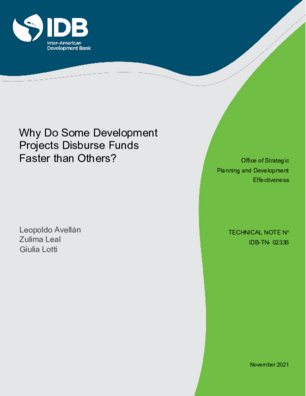Why do some Development Projects Disburse Funds Faster than Others
Date
Nov 2021
The timely disbursement of funds is a necessary condition for the success of international development projects. Disbursements track the progress of projects in completing the products that ultimately will deliver the projects desired outcomes. Moreover, in a world with pressing needs for external financing, project disbursements are an important source of external liquidity for recipient countries. However, some projects start disbursing faster than others and at relatively larger amounts. Hence learning why some projects disburse faster than others is important to understand not only which projects are more likely to achieve development outcomes sooner, but also to assess their value as providers of external liquidity in times of distress. As it has become evident over the past year with the COVID-19 pandemic, multilateral lending has played a crucial role in helping emerging countries face the larger financing needs originated by the crisis. In 2020, Inter-American Development Bank (IDB) disbursements increased 49% over 2019, reaching $13.4 billion, more than doubling the baseline disbursement projection. This paper assesses which observable characteristics of investment loans offered by the IDB are associated with faster disbursements. The results indicate substantial heterogeneity across countries, sectors, and loan modalities. All else constant, results-based loans and loans in the social sector are more likely to disburse within 2 years after being approved. Projects in countries where it takes longer to meet at least some of the clauses to start disbursing are less likely to start disbursing 2 years after approval. Projects that are expected to have longer execution times disburse at slower speeds within 24 months after approval. Overall, country factors seem to play a more relevant role than sectorial factors in explaining the probability that a project will disburse funds quickly. These and other findings in the paper can inform future programming exercises and help optimize the disbursement processes.




